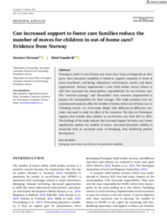Norwegian youth in out-of-home care move three times as frequently as their peers. Such placement instability is linked to negative outcomes in terms of social attachment, well-being, educational achievements, health, and future opportunities. Norway implemented a new child welfare service reform in 2022 that increased the municipalities responsibilities for out-of-home care. The “incentive package” and “Barneløftet” were measures implemented to prepare the municipalities for these changes.
This study evaluates how the implemented measures affect the number of moves within out-of-home care in Trøndelag county, Norway. An event-study design with difference-in-difference estimates was used to study the effect of the measures. The data are Norwegian registers that include most children in out-of-home care from 2013 to 2021.
The findings of this study indicate that increased support for foster care homes significantly reduces the number of moves. Increased placement stability is associated with an increased sense of belonging, thus facilitating positive development.

